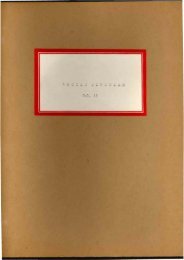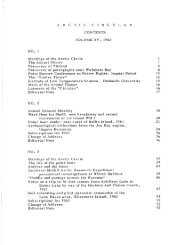Volume 4, 1951 - The Arctic Circle - Home
Volume 4, 1951 - The Arctic Circle - Home
Volume 4, 1951 - The Arctic Circle - Home
Create successful ePaper yourself
Turn your PDF publications into a flip-book with our unique Google optimized e-Paper software.
forme <strong>The</strong> terrain was completely snow-covered and almost<br />
aIl the lakes were frozen, though still fairly clear of<br />
snow. Map reading was therefore easy in aIl areas where<br />
the maps were good, which on this flight was more than half<br />
of the way. As we approached Great Slave Lake an increasing<br />
amount of open water was observed, mostly in rivers and lakes<br />
with a strong through current, but occasionally in lakes with<br />
no apparent major outlet. Great Slave Lake was completely<br />
open, and no ice was seen even in the narrow channels of the<br />
East Arro, or along the shore.<br />
<strong>The</strong> second flight, on October 29, was from Churchill<br />
to Resolute Bay via the magnetic pole, and then, after refuelling,<br />
north to Stor Island in Eureka Sound and back to<br />
Churchill. Visibility was zero until Baker Lake was reached,<br />
where clouds cleared to reveal a sroooth solid sheet of ice<br />
much of which was blown bare of snow.<br />
vie crossed the coast at Sherman Inlet, and from here<br />
on ice conditions were not only the most interesting but<br />
almost the only subject of observation, as the islands were<br />
largely obscured by cloud. ln Victoria Strait and M'Clintock<br />
Channel the ice was solid and heavy and covered vrith snow.<br />
Gnly a few leads, most of them refrozen, broke the uniformity.<br />
This ice looked old and was very much ridged, many of the<br />
ridges having a worn-down, eroded look.<br />
A considerable amount of haze and cloud prevented us<br />
from seeing very much of Prince of Wales Island. Bellot Cliff<br />
at its northeast corner made quite a striking landmark. <strong>The</strong><br />
ice in Barrow Strait presented a very different appearance<br />
from that seen farther south, consisting of a jumble of ice<br />
pans of different sizes, shapes, and general appearance,<br />
which were cemented into a more or less solid sheet by young<br />
ice. Leads were corumon, some of them open, some frozen over<br />
or in process of freezing.<br />
After leaving Resolute it rapidly became dark and<br />
little further observation was possible. On the vJay back to<br />
Churchill an unexpected change of wind blew the aircraft off<br />
course. However, it did not take the dozen or so navigators<br />
on board very long to figure out that it was the aircraft and<br />
not the stars that was in the wrong place, and suitable corrective<br />
action was taken. A display of aurora was visible in the<br />
west as we flew down the west coast of Hudson Bay.












